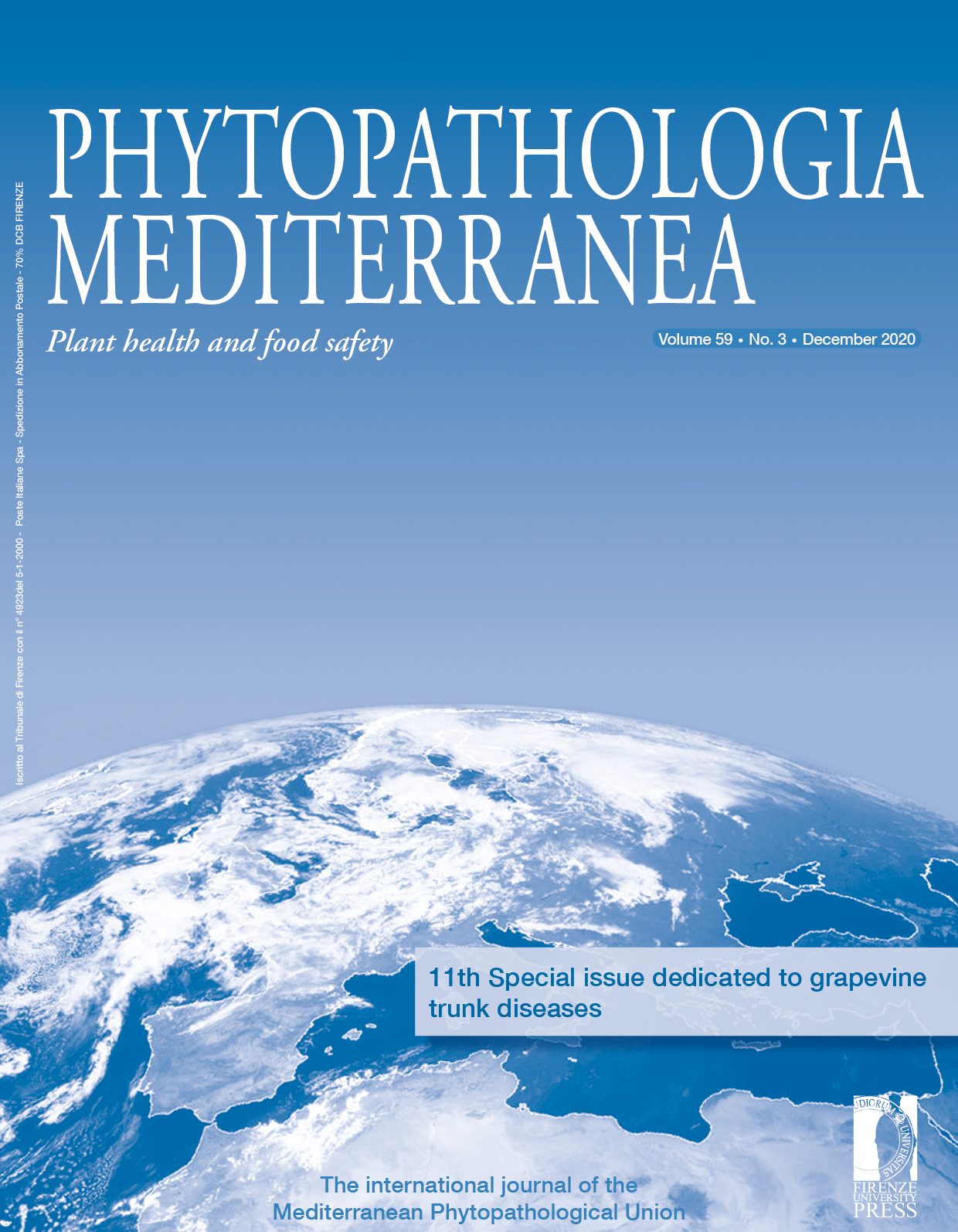Aerial inoculum patterns of Petri disease pathogens in South African vineyards and rootstock mother blocks
Published 2020-10-11
Keywords
- Phaeomoniella chlamydospora,
- Phaeoacremonium spp.,
- Vitis spp.,
- epidemiology,
- spore release
How to Cite
Abstract
Petri disease is caused by the xylem inhabiting fungi Phaeomoniella (Pa.) chlamydospora and several Phaeoacremonium (Pm.) species. Pruning wounds are known host ports of entry for aerial spores of these pathogens. However, knowledge is lacking on occurrence of these pathogens as aerial inoculum within South African vineyards. This study determined when spores of Petri disease pathogens are released in Western Cape Province vineyards and how these spore release events coincided with pruning activities when infections could occur. The research was conducted for two seasons from mid-May to early December 2012 and from mid-March to early December 2013. Microscope slide spore traps were affixed to arms of infected vines in six vineyards and mother vines in two rootstock mother vine nurseries. The slides were replaced weekly and fungal spores were retrieved from them, cultured, counted and identified. Colonies resembling those of Pa. chlamydospora and Phaeoacremonium spp. were subcultured for further molecular identification. Species of Phaeoacremonium were identified by amplification of the partial beta-tubulin gene. Taqman probes and primers were developed to facilitate fast detection of the most frequently occurring species (Pm. minimum, Pm. parasiticum and Pm. sicilianum), using real-time PCR. Petri disease pathogens occurred throughout the periods investigated. Phaeomoniella chlamydospora and Pm. minimum were trapped in all vineyards. A total of 14 Phaeoacremonium species were identified, with the greatest diversity ever recorded in vineyards, including Pm. australiense, Pm. griseo-olivaceum, Pm. griseorubrum, Pm. inflatipes, Pm. iranianum, Pm. italicum, Pm. minimum, Pm. parasiticum, Pm. prunicola, Pm. scolyti, Pm. sicilianum, Pm. subulatum, Pm. venezuelense and Pm. viticola. Of these, only Pm. minimum and Pm. inflatipes have been reported as aerial inoculum within vineyards. Spore release coincided with winter and spring pruning activities. The occurrence of six Phaeoacremonium species in rootstock mother vine nurseries highlights the high risk of pathogen spread through infected nursery material. This is the greatest Phaeoacremonium species diversity ever recorded in vineyards and the first detection of Phaeoacremonium species aerial inoculum in grapevine rootstock mother vine nurseries. The high species diversity and frequency of spore release in vineyards and rootstock mother vine nurseries coinciding with traditional pruning practices emphasizes the need to develop effective wound protection strategies to avoid infection of unprotected grapevine pruning wounds.
Downloads
References
Instituto de Ciencias de la Vid y del Vino (ICVV)
Tel: 941 89 49 80 Ext. 410058
david.gramaje@icvv.es
Trunk diseases expert (etiology, epidemiology as well as management)
Prof Josep Armengol
Dept. of Agroforest Ecosystems
Universitat Politècnica de València | UPV
Institute of Mediterranean Agroforestry (IAM)
jarmengo@eaf.upv.es
+34 963 879 254
Expert in trunk diseases with practical experience in Phaeomoniella spore trapping.
Dr. Plilippe Larignon
The French Institute of Vine and Wine (IFV)
Phone: 04 66 20 67 00
philippe.larignon@vignevin.com
Trunk disease expert, including the first ever study worldwide on the biology (spore trapping) of Petri disease pathogens, Pchlamydospora and Pm minimum.
Dr. Suzanne Rooney Latham
California Department of Food & Agriculture
916-738-6711 office,
suzanne.latham@cdfa.ca.gov
Expertise in Petri disease etiology and epidemiology (spore trapping in California).
Prof Michael Fischer
Julius Kühn-Institut (JKI)
Federal Research Institute for Cultivated Plants, Geilweilerhof, Germany
Tel:+49 (0)6345 41 211
michael.fischer@julius-kuehn.de
Trunk disease expert (etiology, epidemiology and management)







